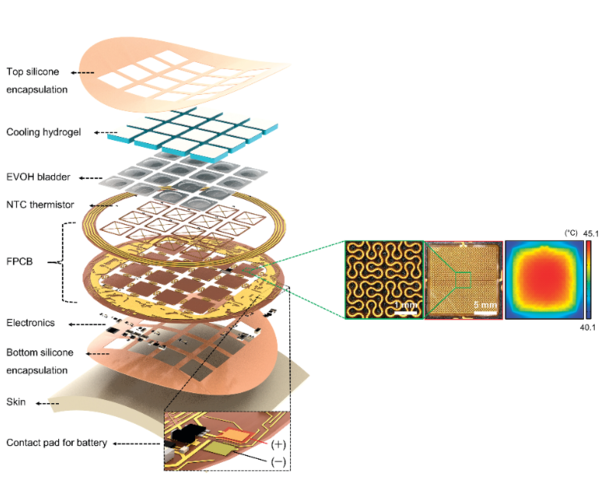Hanyang University
College of Engineering
 NewsFaculty
NewsFaculty
Faculty
| New Technology to Implement Temperature in VR (Virtual Reality) Is Developed | |
|---|---|
|
작성자 : 한양대학교 공과대학(help@hanyang.ac.kr) 작성일 : 23.03.23 조회수 : 132 URL : |
|
|
Provides vivid sensations with a skin-attached cold-and-hot sensation interface Professor Jung Yei-hwan of Hanyang University’s School of Electronic Engineering, with Drs. Park Min-su and Yoo Jae-Young from Professor John Rogers’s research team at Northwestern University, has developed a skin-attached cooling and heating interface that implements the temperature of objects in virtual reality (VR), going beyond simple vibration. The technology can be applied not only to the hands but also to a large area of the skin, which is expected to enable more vivid sensory experiences in VR and the metaverse. Recently, the development of artificial sensory technologies has been actively progressing with the rapid growth of metaverse technologies, such as virtual reality (VR), augmented reality (AR), and telehaptics. Haptic is an artificial sensory technology that allows one to feel touch, power, and movement through an input device. Pre-existing haptic devices are commercialized in the form of gloves or full-body suits. However, not only they are too large or heavy, but also they have behavioral constraints due to the wired system and reduced spatial resolution of various stimuli to be transmitted to the skin. In addition, there have not been actively conducted research on systems that provide thermal sensations. As an alternative, Professor Jung’s team developed a thermally controlled epidermal VR (t-eVR). The T-eVR is an interface that implements flexible, skin-attached cooling and heating sensations through fine-sized cold patches and Joule heaters, electrical devices that control temperature accurately and quickly. It is thinner and lighter than conventional commercialized devices and is designed to enable communication and be operated wirelessly using Bluetooth, thereby minimizing behavioral restrictions. In addition, the cooling and heating modes are implemented in a fast and power-efficient manner. Accordingly, effective cooling and heating sensations can be transmitted to the skin in a wider area through various stimulation patterns, and accurate temperature control is possible. The t-eVR device is lighter and can be more freely designed than conventional haptic devices. In addition, many areas, such as wireless communication capabilities, graphical user interfaces, and convenient access to the Internet, have been further developed. This technology is expected to be highly utilized in addition to VR. Professor Jung’s team succeeded in various applications, including relaying temperature information transmitted from the developed t-eVR device to a cloud server to deliver stimulation patterns even at a location 20 km away or detecting temperature distribution of any object, in pixels, through a mobile infrared (IR) camera and transmitting them to the device in real time. The technology is expected to be able to be applied in various ways to entertainment, education, rehabilitation, and remote patient care in the future.
The findings of Professor Jung Yei Hwan’s team were published in the January 30 volume of the “Proceedings of the National Academy of Sciences,” a world-renowned international journal with an impact factor of 12.779.
Schematic diagram of a flexible skin-attached cooling-an-heating sensation implementing interface |
|
| 이전글 | Winning a Research Project from the U.S. Army Research Institute |
| 다음글 | Identifying Visuomotor Circuits for Drosophila's Evasive Flight |
|
|

